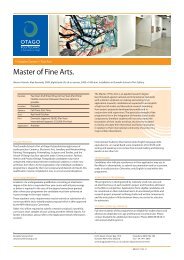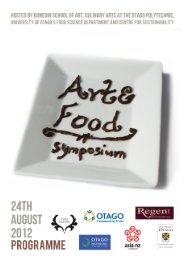Dunedin School of Art Postgrad Booklet.indd - Otago Polytechnic
Dunedin School of Art Postgrad Booklet.indd - Otago Polytechnic
Dunedin School of Art Postgrad Booklet.indd - Otago Polytechnic
Create successful ePaper yourself
Turn your PDF publications into a flip-book with our unique Google optimized e-Paper software.
10<br />
Clive Humphreys<br />
Studio Supervisor<br />
In the four decades Clive Humphreys has practised<br />
as a pr<strong>of</strong>essional artist, he’s been called a lot <strong>of</strong> things.<br />
He’s a painter, a printmaker, a multi-media artist. His<br />
work – regularly exhibited throughout New Zealand<br />
and overseas and honoured in national awards and<br />
collections – has embraced history, abstraction and<br />
popular culture.<br />
His formal roles are principal lecturer, manager <strong>of</strong> the <strong>Dunedin</strong><br />
<strong>School</strong> <strong>of</strong> <strong>Art</strong>’s painting, printmaking and textiles section and<br />
postgraduate studio supervisor.<br />
The process <strong>of</strong> exploring<br />
these possibilities, making<br />
decisions about what<br />
you really want to focus on,<br />
and evaluating it as you go<br />
is the challenge and joy <strong>of</strong><br />
master’s study.”<br />
Photography: Tessa Barringer<br />
OTAGO POLYTECHNIC – TE KURA MATATINI KI OTAGO<br />
But you’d have been hard-pressed to call Clive a pencil-wielding<br />
landscape artist. Until he went for a walk recently. “I wanted to<br />
walk as much <strong>of</strong> Waiheke Island as I could,” he explains. His aim<br />
was to document plants and nature, in the spirit <strong>of</strong> the botanical<br />
artists who rendered close observations <strong>of</strong> the worlds around<br />
them, and develop themes that had recently emerged in his<br />
paintings.<br />
“But the act <strong>of</strong> drawing became so compelling, it took over,”<br />
says Clive. Now, his latest works are very large landscape<br />
drawings, capturing the Island’s wind-gnarled pohutukawa<br />
and dramatic bluffs.<br />
“I had a choice really: to go back to the original idea, or to relax<br />
into where my interests were taking me. It was a wonderful feeling<br />
when I just allowed myself to go with it.” The result is a new series<br />
<strong>of</strong> works, soon to be shown in Waiheke.<br />
It was a crossroads, he says, he recognises well. “As a studio<br />
supervisor, students will begin with a project proposal, but this<br />
will inevitably change and morph. The process <strong>of</strong> exploring these<br />
possibilities, making decisions about what you really want to<br />
focus on, and evaluating it as you go is the challenge and joy<br />
<strong>of</strong> masters study.”<br />
Clive says he loves going along to students’ graduation exhibitions,<br />
and pulling out the original proposal they began with. “It’s<br />
fascinating to see not just the differences but also the threads<br />
that have remained strong.<br />
“I tell my students that if things don’t change, they may not have<br />
learned much.” Indeed, after 40 years as an artist, it’s a philosophy<br />
Clive still seems to be living by.








